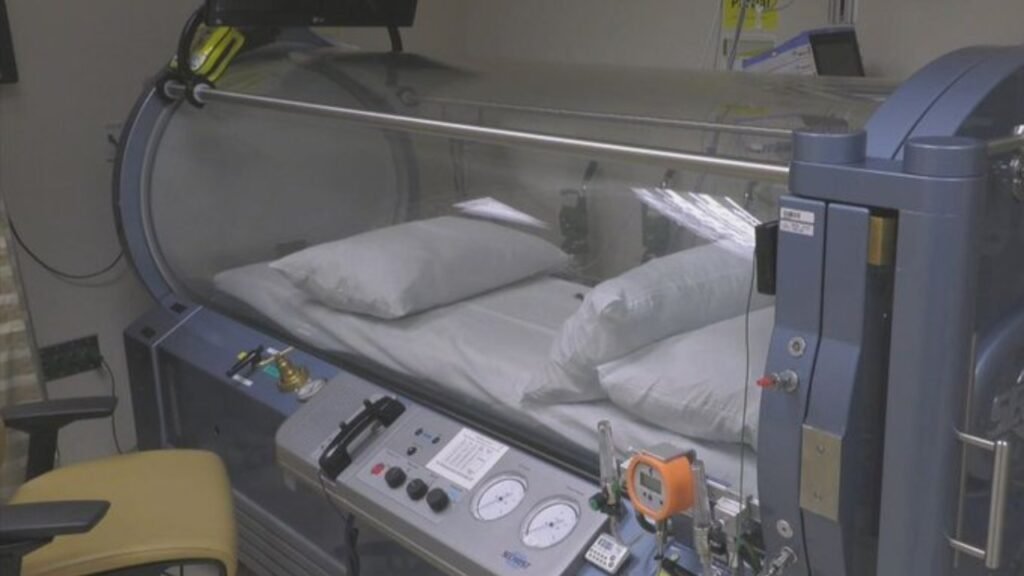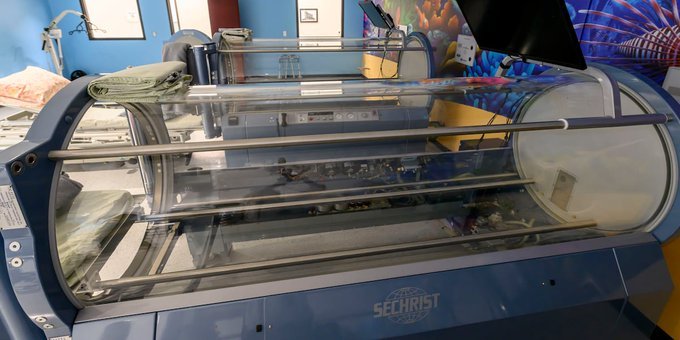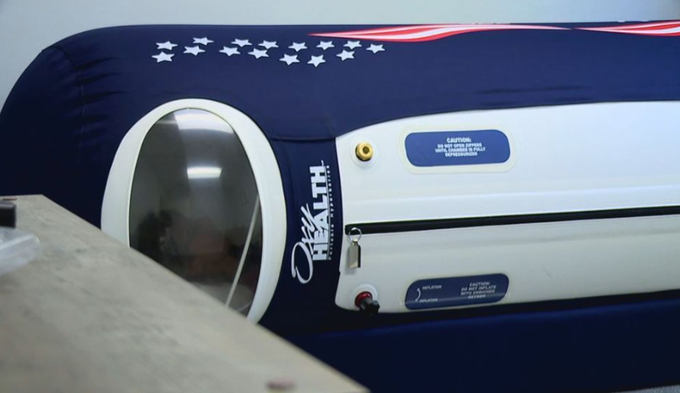Explosive Tragedy: 5-Year-Old Dies In Rare Hyperbaric Chamber Blast In Michigan
- Leave a Comment
- James M
- February 1, 2025

The Oxford Center in Troy, Michigan, experienced a catastrophic event on the morning of February 1st, 2025, when a hyperbaric oxygen chamber exploded. Medical personnel and local officials were shocked when the explosion occurred at around 8 a.m.
This event was the first of its kind at the facility, which is well-known for providing hyperbaric oxygen therapy (HBOT) for a variety of medical ailments. The neighborhood was devastated by the unexpected explosion, which also raised grave questions regarding the safety of hyperbaric chambers.
A 5-year-old kid from Royal Oak, Michigan, was receiving treatment inside the pressurized oxygen chamber when the explosion occurred, and he died as a result. The infant was declared deceased at the site despite prompt emergency response attempts.
While standing close by during the procedure, his mother sustained injuries to her arms but managed to survive. The focus now is on determining what caused the hyperbaric chamber mishap, though authorities have not yet revealed the precise medical issue the kid was receiving treatment for.
The 100% oxygen content of hyperbaric chambers greatly raises the possibility of combustion at high pressure, according to Troy Fire Lt. Keith Young. Although oxygen chamber explosions are exceedingly rare, hyperbaric oxygen therapy is generally regarded as safe.
Investigators are still trying to pinpoint the exact origin of the explosion, although preliminary indications suggest that a fire began inside the chamber. In order to guarantee a comprehensive analysis of the hyperbaric chamber collapse, the inquiry has been turned over to state authorities due to the incident’s seriousness.
The Oxford Center, which has been offering hyperbaric oxygen therapy for more than 15 years, said it was deeply saddened by the incident and emphasized how patient safety is their first concern. The establishment promised the public in a statement that they would work closely with investigators to identify the cause of the hyperbaric chamber explosion.
The incident has raised worries about the risks of hyperbaric treatment and the need for improved safety standards in medical facilities, while the community mourns the loss of such a young life.

Hyperbaric oxygen therapy: what is it?
A specialist medical procedure called hyperbaric oxygen therapy (HBOT) entails breathing 100% oxygen under pressure. By improving oxygen flow to tissues, this therapy promotes the body’s natural healing process, which makes it advantageous for a variety of illnesses.
HBOT is frequently used to help patients with neurological problems, infections, and chronic wounds in hospitals, clinics, and specialized treatment facilities. Despite being widely regarded as safe, hyperbaric chamber treatment has recently come under scrutiny for its hazards, which include the extremely rare but potentially disastrous chance of hyperbaric chamber explosions.
Treating decompression sickness, or “the bends,” is one of the main applications for hyperbaric oxygen therapy. Nitrogen bubbles accumulate in the circulation of divers who surface too rapidly, resulting in joint pain, lightheadedness, and even paralysis. By raising atmospheric pressure, HBOT aids in the removal of these bubbles and permits nitrogen to return to the bloodstream in a safe manner.
Oxygen chamber therapy is also frequently utilized for severe tissue wounds and infections, especially in patients with burns, radiation-induced tissue damage, and diabetic foot ulcers. HBOT speeds up healing and lowers the chance of amputation in extreme situations by supplying high oxygen concentrations to the injured areas.
In cases of carbon monoxide poisoning, hyperbaric oxygen treatment is another essential use. Vital organs experience oxygen deprivation as a result of carbon monoxide’s superior ability to bind to hemoglobin in the blood. By quickly eliminating carbon monoxide, HBOT restores normal oxygen levels and guards against long-term brain damage.
Hyperbaric oxygen chamber therapy may also aid cancer patients receiving radiation therapy since it increases blood flow to the damaged areas and repairs radiation-induced tissue damage. These various medical uses demonstrate how well hyperbaric therapy works for both chronic and life-threatening illnesses.
The safety of hyperbaric oxygen therapy remains a worry despite its many advantages. Although oxygen chamber accidents are exceedingly rare, they can have disastrous outcomes, even though HBOT is typically considered a low-risk, FDA-approved treatment. Even a tiny igniting source can produce a hyperbaric chamber fire or explosion since these chambers contain extremely concentrated oxygen under pressure.
Strict hyperbaric chamber safety procedures, such as the use of fire-resistant materials, adequate ventilation, and routine maintenance inspections, are therefore in place. Significant concerns regarding possible oxygen therapy hazards and the requirement for ongoing advancements in hyperbaric treatment safety regulations have been brought to light by the hyperbaric chamber explosion in Troy, Michigan.
SHOCKING ACCIDENT: 5-year-old boy killed in hyperbaric chamber explosion at Michigan medical center. https://t.co/HySRVllJYS pic.twitter.com/pJ755fhH14
— News 4 San Antonio (@News4SA) January 31, 2025
Information about the Explosion and Its Repercussions
Around 8 a.m. on February 1st, 2025, a 5-year-old child receiving hyperbaric oxygen therapy (HBOT) at The Oxford Center in Troy, Michigan, experienced a tragic hyperbaric chamber explosion. An unanticipated explosion inside the pressurized oxygen chamber resulted in catastrophic chamber damage.
Despite the efforts of emergency personnel, the youngster who was trapped inside at the time of the explosion was declared dead at the site. Serious questions concerning the safety of hyperbaric chambers and the dangers of oxygen therapy treatment have been brought up by the incident.
When the explosion occurred, the mother of the child was standing next to the chamber and sustained injuries to her arms. Troy Fire Lt. Keith Young reports that she suffered severe burns and upper body trauma as a result of the blast’s impact.
Her injuries were deemed non-life-threatening, but she was taken right away to a local hospital for treatment. Staff and first responders were shocked by the hyperbaric chamber mishap, which highlighted the risks of pressurized oxygen therapy when safety procedures are not followed, even though she was the only other person physically impacted.
No other injuries were reported, despite the presence of other medical staff in the room. But the chamber was seriously damaged by the explosion, and the impact started a fire inside the space. To put out the fire before it spread to other areas of the building, first responders had to move swiftly.
The fire may have been caused by the highly concentrated oxygen in the chamber being flammable, which is a known risk factor for hyperbaric oxygen chamber explosions, according to investigators. After the incident, the facility was immediately closed while the cause of the hyperbaric chamber failure was thoroughly investigated.
In order to ascertain the precise reason of the oxygen chamber explosion, authorities have since initiated a state-led investigation. Officials are investigating if the explosion was caused by a possible electrical spark, mechanical failure, or incorrect handling of oxygen equipment, as hyperbaric chamber incidents are exceedingly uncommon.
The Oxford Center, which has provided hyperbaric oxygen therapy for more than 15 years, said it was very saddened by the oxygen chamber tragedy and promised to work with investigators to the fullest extent possible. While the community grieves the loss of a young life, attention is now turning to hyperbaric safety rules and averting future incidents using hyperbaric treatment.
Michigan: 5-Year-Old Passes Away Following Hyperbaric Chamber Explosion At Medical Center https://t.co/Yq2h4J0QYY #OAN
— One America News (@OANN) January 31, 2025
Authorities immediately began looking into the cause of the fatal hyperbaric chamber explosion at The Oxford Center in Troy, Michigan. Speaking to the media, Troy Fire Lt. Keith Young explained that there is a considerable risk of combustion due to the extremely compressed oxygen environment found in hyperbaric oxygen chambers.
A catastrophic oxygen chamber explosion could result from even a small spark or equipment malfunction because 100% oxygen is extremely combustible. Young stressed that although safety regulations for hyperbaric oxygen therapy (HBOT) are normally stringent, this incidence is extremely uncommon and needs careful investigation.
Given the seriousness of the event, state authorities have taken over the inquiry and are currently thoroughly looking into the hyperbaric chamber mishap. Investigators are looking at possible electrical sparks, oxygen leaks, and equipment failures that might have caused the explosion.
The maintenance history of the chamber implicated in the explosion, staff training records, and the hyperbaric safety procedures of The Oxford Center will also be examined by investigators. Although mishaps involving hyperbaric treatments are uncommon, this tragedy emphasizes how crucial it is to enforce stringent oxygen chamber safety protocols in order to avert similar incidents in the future.
The Oxford Center responded to the tragedy by releasing a statement expressing their profound sadness at the young patient’s passing. The clinic noted that nothing similar had previously happened in its 15 years of providing hyperbaric oxygen therapy, underscoring its commitment to patient safety.
The medical center promised the public that they would examine and improve their safety procedures if needed, and they promised to work fully with investigators. However, the hospital has temporarily halted its HBOT services while investigators identify the reason for the hyperbaric chamber failure.
Regulatory agencies, safety specialists, and medical professionals are keeping a careful eye on the investigation’s results. Concerns regarding the necessity of updating or strengthening hyperbaric chamber safety rules at locations across the country have been highlighted by this oxygen chamber tragedy.
Although thousands of patients benefit from hyperbaric oxygen therapy, the catastrophic hyperbaric explosion in Michigan serves as a sobering reminder of the dangers associated with high-pressure oxygen environments. In addition to giving the bereaved family answers, authorities believe that their research will help to increase the safety of hyperbaric treatments going forward.

The local community in Troy, Michigan, is in shock and grief following the hyperbaric chamber explosion. Family members, medical personnel, and residents have all been grieved by the untimely death of a 5-year-old child during what was meant to be a typical hyperbaric oxygen treatment (HBOT) session.
Following such an uncommon and devastating incident, many members of the Royal Oak and Troy communities have voiced their sorrow and concerns regarding the safety of hyperbaric oxygen treatment. To pay tribute to the young victim and assist his bereaved family, candlelight vigils and community service initiatives have been planned.
This tragedy emphasizes how crucial medical safety procedures are, especially in high-risk settings like pressured oxygen therapy. Strict safety precautions are necessary since using 100% oxygen in a hyperbaric chamber greatly raises the risk of combustion and fire.
This occurrence calls into question whether the safety restrictions now in place for oxygen chambers are adequate, even if hyperbaric oxygen therapy helps many patients by promoting wound healing and treating ailments like decompression sickness and carbon monoxide poisoning. To avoid another hyperbaric oxygen chamber mishap in the future, the medical community must now reassess the risk factors related to hyperbaric chamber therapy.
The deadly hyperbaric chamber explosion might also have repercussions for the whole business, leading to a review of safety procedures at hyperbaric treatment facilities across the country. To lower the danger of oxygen chamber failures, regulatory bodies and specialists in hyperbaric medicine may advocate for stronger regulations, more employee training, and more fire safety precautions.
New industry regulations may result from this tragedy, mandating that hyperbaric clinics adopt stricter protocols for oxygen handling, equipment maintenance, and emergency response training. In order to safeguard future patients, medical personnel and facility managers will now be under pressure to improve hyperbaric chamber safety regulations.
This hyperbaric chamber catastrophe has had a significant emotional and psychological impact in addition to its medical and legal ramifications. The mother, who survived the explosion, is dealing with emotional and physical anguish, while the child’s family is experiencing an unfathomable loss. Many of the Oxford Center’s employees saw the explosion, thus they might also experience sadness and post-traumatic stress disorder.
The emotional toll that medical tragedies can have on families, healthcare professionals, and entire communities is painfully brought home by this oxygen chamber tragedy. Understanding the cause of the hyperbaric chamber collapse, providing support to individuals impacted, and guaranteeing patient safety in future hyperbaric oxygen therapy are all priorities as the investigation progresses.
Improved safety procedures at healthcare facilities providing hyperbaric oxygen therapy (HBOT) are desperately needed, as demonstrated by the catastrophic hyperbaric chamber explosion in Troy, Michigan.
This incident shows the possible risks of pressurized oxygen therapy when safety precautions are not followed, even though HBOT has long been thought to be a safe and effective treatment for ailments like decompression sickness, carbon monoxide poisoning, and radiation-induced injuries.
In order to prevent similar fatalities, healthcare professionals and regulatory organizations must respond quickly to reevaluate and reinforce hyperbaric chamber safety measures while investigators try to pinpoint the precise reason of the disaster.
Making sure that all medical personnel who handle high-pressure oxygen chambers have thorough training is essential to preventing oxygen chamber mishaps. A catastrophic hyperbaric explosion can be caused by even the smallest spark, equipment failure, or human error since hyperbaric oxygen chambers contain 100% oxygen in a compressed environment.
Reducing the dangers associated with hyperbaric chamber treatment requires better training programs, more stringent operational requirements, and frequent emergency reaction drills. Facilities should also conduct regular safety checks and make sure that all hyperbaric chamber equipment satisfies the most recent industry standards for pressure management and fire prevention.
Concerns over public trust in hyperbaric oxygen therapy have also been raised by this oxygen chamber tragedy, in addition to the urgent need for more robust safety protocols. Due to concerns of hyperbaric chamber failures, patients and their families who previously believed that HBOT was a safe medical technique may now be reluctant to receive therapy.
In order to reassure the public, healthcare facilities that provide hyperbaric oxygen therapy should be proactive in developing innovative risk-reduction techniques, conducting comprehensive safety evaluations, and displaying clear safety rules. For patients who depend on oxygen chamber treatments to continue receiving care without needless anxiety or uncertainty, it will be essential to rebuild confidence in the safety of hyperbaric therapy.
The Oxford Center’s hyperbaric chamber explosion serves as a reminder to the medical community to give safety enhancements in oxygen therapy treatments top priority. To avoid another deadly mishap, every facet of hyperbaric chamber safety needs to be reexamined, from stronger rules and better employee training to better chamber maintenance and fire prevention procedures.
Although thousands of patients benefit annually from hyperbaric oxygen therapy, this incident serves as a sobering reminder that safety must always come first when receiving medical treatment in high-pressure oxygen conditions.
Conclusion:
In addition to killing a 5-year-old kid, the tragic hyperbaric chamber explosion in Troy, Michigan, has sparked serious questions regarding the safety of hyperbaric oxygen therapy (HBOT). This tragic event is a clear reminder of the dangers of high-pressure oxygen therapy and the necessity of strict safety protocols in healthcare facilities that administer it.
This tragedy emphasizes the significance of ongoing vigilance, stringent safety measures, and routine equipment maintenance to maintain patient safety, even if hyperbaric oxygen therapy has assisted in the recovery of innumerable individuals from severe medical illnesses.
The family of the young victim, whose life was sadly cut short, has our sincerest sympathies. In a hospital setting where safety is supposed to be the first consideration, no parent should ever have to go through such an unfathomable tragedy.
We also offer our condolences to the mother who suffered injuries, as well as to the first responders and medical personnel impacted by this terrible incident. Many people will be affected emotionally and psychologically by this oxygen chamber tragedy, and the community must unite to offer healing, compassion, and support during this trying time.
We can only hope that as the hyperbaric chamber explosion inquiry progresses, state investigators and medical professionals will determine the precise reason of this catastrophe and put into practice practical safety measures to stop future occurrences of this kind.
This catastrophe must prompt a thorough examination of hyperbaric chamber safety rules, regardless of whether the explosion was the result of human mistake, electrical malfunction, or equipment failure.
To guarantee that HBOT continues to be a safe and efficient treatment option, facilities that provide it must use this tragedy as a chance to improve staff training, fortify their safety processes, and implement more stringent maintenance guidelines.
The lessons acquired from this tragedy must lead to significant change in the medical field, even though no safety precaution will erase the suffering inflicted by this hyperbaric chamber disaster.
We can pay tribute to the small child who died in this tragedy by raising awareness of the dangers of oxygen chamber safety, enforcing stricter industry standards, and putting patient protection first. To ensure that no other family has to suffer a similar loss in the future, this tragic incident must act as a spur for enhancing the safety of hyperbaric treatment.
